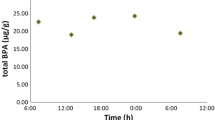Summary
Exposure to a new wood preservative agent (Sinesto B), whose active ingredient is 2-ethylhexanoic acid (2-EHA), was determined by urinalysis of the parent chemical and its metabolites in workers employed in four Finnish sawmills. The excretion of these chemicals was compared with the inhaled dose analyzed in air samples collected at the breathing zone and with the percutaneous absorption determined by epicutaneous sampling. The main route for entrance of 2-EHA into the body is by breathing, because the urinary concentration of 2-EHA correlated linearly with the concentration of 2-EHA in the air (r = 0.70). There was no correlation between skin contamination and urinary levels of 2-EHA. In most cases the highest urinary concentrations of 2-EHA were found immediately after the work shift. Therefore, in order to evaluate a worker's exposure, the urine sample has to be taken immediately after the work shift. Workers in cranes had the highest exposure to 2-EHA, which describes well the evaporation of Sinesto B into the ambient air. 2-EHA was not found in the urine of non-exposed workers.
Similar content being viewed by others
References
Åkerblom M, Kolmodin-Hedman B, Höglund S (1983) Studies of occupational exposure to phenoxy acid herbicides. In: Miyamamoto J (ed) IUPAC Pesticide Chemistry. Pergamon Press New York, pp 227–232
Gal P, Oles K, Gilman J, Weaver H (1988) Valproic acid efficacy, toxicity and pharmacokinetics in neonates with intractable seizures. Neurology 38:467–471
Kröger S (1990) Gas chromatographic-mass spectrometric analysis of 2-ethylhexanoic acid (2-EHA) as pentafluorobenzyl ester in urine. Analyst (in press)
Manninen A, Kangas J, Klen T, Savolainen H (1986) Exposure of finnish farm workers to phenoxy acid herbicides. Arch Environ Contam Toxicol 15:107–111
Manninen A, Kröger S, Liesivuori J, Savolainen H (1989) 2-Ethylhexanoic acid inhibits urea synthesis and stimulates carnitine acetyltransferase activity in rat liver mitochondria. Arch Toxicol 63:160–161
Marini AM, Zaret BS, Beckner R (1988) Hepatic and renal contributions to valproic acid-induced hyperammonemia. Neurology 38:365–371
Author information
Authors and Affiliations
Additional information
Supported by the Finnish Work Environment Fund, Helsinki, Finland
Rights and permissions
About this article
Cite this article
Kröger, S., Liesivuori, J. & Manninen, A. Evaluation of workers' exposure to 2-ethylhexanoic acid (2-EHA) in Finnish sawmills. Int. Arch Occup Environ Heath 62, 213–216 (1990). https://doi.org/10.1007/BF00379435
Received:
Accepted:
Issue Date:
DOI: https://doi.org/10.1007/BF00379435




